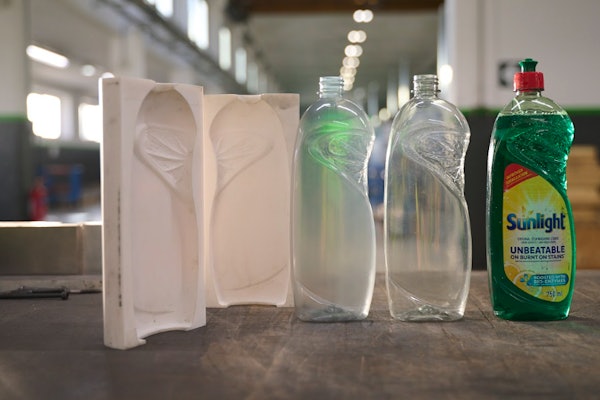And that is what accounts for the feverish pleadings of the Cosmetic, Toiletry and Fragrance Assn., the Chemical Specialties Manufacturers Assn., the Adhesive and Sealant Council, other trade groups and numerous individual companies. Targeted products include adhesives, automotive chemicals, workshop chemicals, metal polishes, spot removers or cleaning fluids, shoe polishes and lubricants. Because of their toxicity, children ingesting them could choke or vomit, thereby drawing the chemicals into their lungs and becoming poisoned. Packagers are wary of the pending CPSC rulemaking. Asked about potential impact, John McKeegan, spokesman for Johnson & Johnson's Consumer Products Div., Skillman, NJ, says, "We don't know. It is too early to say." Johnson's baby oil, for example, contains mineral oil, a petroleum distillate. A CPSC rule would affect a wide range of automotive products sold in bottles and cans. Bill Hann, manager of packaging design for STP Products, Danbury, CT, says products sold in containers with aerosol pumps or trigger nozzles would be the most seriously affected. Vendors such as Specialty Packaging, now owned by Owens-Brockway (Toledo, OH), sell a CRC for trigger dispensers. However, Hann estimates that use of the CRC increases the cost of the dispenser by 25%. Not only would STP have to pass along some or all of that cost increase, it would also have to increase the selling price to reflect the increased legal liability it would be subject to should a child poisoning take place. STP's costs would also increase because of the new imperatives for more diligent quality control on the trigger sprayer assembly line. Aside from costs, an additional downside of a CRC trigger sprayer is that it makes it difficult to refill the bottle, a fact that can especially discourage senior citizens from buying the product. Lastly, Hann believes that although there are vendors such as Specialty Packaging offering CRC trigger sprays, those vendors do not have nearly enough molds to satisfy what could be a huge increase in demand. "The CPSC can mandate that we use CRC trigger sprays," he says. "But the agency cannot force vendors to spend $250ꯠ on injection molds." Making spray cans compliant would be easier. Hann says there are CRCs available for aerosol spray cans, either the old-style screw-driver slot type, or the newer "button" caps that fit over the spray button. "There is not too much involved in making that transition," Hann explains. STP is already half way there on its squeeze bottles. Two years ago, STP went to CRCs. Now all it would have to do to comply with a CPSC final rule is to permanently attach those caps to the body of the bottle so the cap could not be screwed off. "We could do that in three months," Hann says. Of course, many other companies selling products in squeeze bottles, for example J&J, are not that far along. Types of sprays The CPSC has said that aerosols and triggers that spray in a mist would likely be exempt from a CRC mandate. However, the triggers would have to be permanently attached to the bottle. But the Chemical Specialty Manufacturers Assn. (CSMA) believes all aerosol cans should be exempted from the rule, even those that dispense product in a stream. Brigid Klein, regulatory counsel to CSMA, wrote to the CSMA: "The great weight of the data available from poison control centers indicates that pressurized aerosols are extremely unlikely to present a risk of aspiration pneumonitis." The cosmetics industry is arguing that all its products, even bottles that dispense liquids, should be exempt because none of them poses the kind of aspiration problem the CPSC is most worried about. For example, the CTFA says that one manufacturer of a baby oil with a 60-year product history (apt to be J&J) reported only one instance of ingestion. And that was a case of a child sipping baby oil that had been transferred from the original container to a vial, which was stored in a sister's purse left on the floor. The CTFA made its "no harm" claim based on data it assembled from member companies. However, the CPSC has incident data on cosmetics from the American Assn. of Poison Control Centers. The CTFA eventually received that data from the CPSC; but Irene Mellman, CTFA spokeswoman, declines to say whether the AAPCC data shows cosmetics have had a spotless safety record concerning kids under age five. Exemptions not discussed Suzanne Barone, project manager for poison prevention at the CPSC, also declines to discuss the AAPCC statistics on cosmetics. She says the staff has not made any decisions on whether to exempt cosmetics, aerosol stream sprayers or other products or containers. The CPSC will have to take a clear position when it publishes a proposed rule, which is the next step. The CPSC published what is called an advance notice of proposed rulemaking (ANPR) in 1997, where it first discussed its concerns. Ann Brown, the current commissioner of the CPSC, backed that action. Barone says the staff is recommending that the commission issue a proposed rule. She laid out the staff's plans in the November 1998 meeting to which many trade associations were invited. Eventually, the CPSC would have to issue a final rule before any CRC requirements could take effect. The CPSC must meet some thresholds before it can establish any new rules. First, the agency has to prove that special packaging is necessary to protect children from serious personal injury or illness resulting from handling, using or ingesting the substance. If the agency leaps that hurdle, it must also prove that child-resistant packaging is "technically feasible, practicable, and appropriate." Obviously, packagers would face substantial new packaging costs should the CPSC go ahead. One baby oil manufacturer queried by the CTFA estimated that a requirement for CRC would force it to spend $1 million for new molds for bottles, new caps and new tooling for product filling lines. But a CRC requirement would have ramifications beyond additional packaging costs. To the extent that products are used by senior citizens, CRCs could frighten off some portion of that market, a point made by Hann of STP and others. That might be true for baby oil as well as automotive products, and everything in-between. Under the Poison Prevention Packaging Act (PPPA), the CPSC already requires some products containing petroleum distillates such as lighter fluids, paint solvents and varnishes, and nonemulsion liquid furniture polish to have CRCs. But other products with similar compositions have no child-resistant packaging requirement. Once the CPSC determines which products to cover, it may require other packaging restrictions beyond CRC caps. For example, the CPSC's current requirement for furniture polish includes an additional requirement that no more than two milliliters of product be obtained when the container is shaken, squeezed or activated one time. The CPSC thinks this kind of additional "restricted flow" requirement might--and no decisions have been made on this--be necessary for products that are most likely to be left around the house and not put back in a cabinet, and those with viscosities under 50 Saybolt Universal Seconds (SUS) at 100°F. It is products with SUS below 100°F that the CPSC is considering regulating, but only if they contain more than 10% petroleum distillates or hydrocarbons. The hydrocarbons the CPSC is concerned with are those derived from petroleum such as benzene, toluene and xylene. Their presence in paint solvents are the reason those products are roped into the PPPA requirements for child-resistant packaging. However, there are hydrocarbons derived from wood and fruit such as turpentine, pine oil and limonene that also pose an aspiration problem. Barone says products containing pine oil will not be regulated.




















